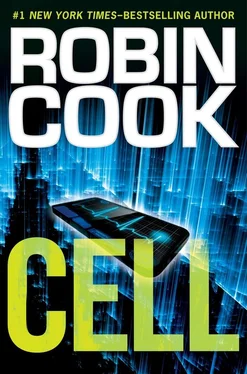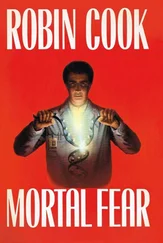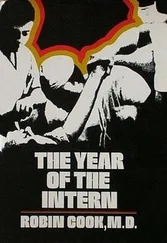Paula led George through the massive white marble lobby and over to a concierge desk, where she arranged visitor credentials for George. With the proper guest pass in hand, they approached the bank of elevators, where the IDs were scrutinized by two large and intimidating guards.
“They take security seriously here,” George said under his breath as they entered an elevator.
“You don’t know the half of it,” Paula replied.
After they exited the elevator they had to show their credentials to another couple of guards at the entrance to the call center. Even though they obviously knew Paula, they checked her ID and scanned it into a reader along with George’s. Paula and George walked into what looked like a call center on steroids. It was a massive open space divided into comfortable cubicles with six-feet-tall, thick glass partitions serving as walls. Each office was occupied by a single, carefully groomed, white-smocked man or woman. Each cubicle also held a sleek glass table and ergonomic chair. And that was it. Nothing else. There were no computers, no monitors, no headphones, no papers or pens visible. Nothing, save an occasional insulated coffee mug. What astounded George was that the glass walls acted as computer monitors. The keyboards were virtual impressions on the glass desktops. George could see images of medical files flashing by. FaceTime-style chats with patients were projected as well. The operators were zooming in on this or that by touching their desktops. George noticed that a few doctors were using some sort of 3D hologram while viewing MRI and X-ray images of internal organs and bone structure. They could manipulate and rotate these images as well. Some of the pictures were going from one doctor to another with texted voice-recognition messages. George was stunned.
Paula could tell George was impressed.
“What the...?”
“Pretty sweet, huh? We combined cutting-edge technology with a couple of Hollywood set designers and... voilà!”
“Tony Stark.”
“Pardon me?”
“ Iron Man. It reminds me of the movie.” George felt as if he had been literally transported into the future.
“It’s funny you say that, because, as I said, we actually did hire some Hollywood set designers to help with the design.” She pointed to various features as she spoke. “Each cubicle is wired for sound so there’s no need for headsets. Cameras are embedded in the glass walls for doctor-to-patient face-to-face chats. That’s why they wear the smocks. Professionalism is key to our patients’ having confidence in the system. We even have a hair and makeup room, and the doctors, they’re all board certified and work only four-hour shifts to ensure that they remain fresh and on top of their game. Overhead air systems suppress the sound of the conversations so there’s no background noise and privacy is protected. Medical records and current vital signs are displayed on the walls, as you can see. Whatever image or file a doctor cares to view is controlled by desktop touch controls. The doctors can also enlarge and highlight and make notes on any image they choose simply by touching their desktops. Three-D holographic technology enables the doctors to better view and evaluate a condition and then diagnose it.”
George noticed a young man and woman in white futuristic outfits similar to those he had seen at the presentation carrying beverages into various cubicles. Paula followed his eyes.
“We want to make the doctors’ experience as pleasant as possible, too,” Paula said, “so, among other things, they can order drinks whenever they want. No food is allowed, though. For that, we have a dining hall. Wolfgang Puck handles the food for us. It’s quite good.”
“I can imagine.”
“The doctors can take breaks whenever needed. There’s no punching the clock here. They earn, on average, twenty-three percent more income on a per-hour basis than that of a typical medical specialist. Their stress levels are much lower, too, because they don’t have to worry about running an office.”
George scanned the room. “You said these are all board-certified doctors?” He noticed that they did appear cheerful. The ones treating patients were doing so with a smile.
“Yep. They’re mostly internists, along with some pediatricians and ob-gyns. We have a few general surgeons, orthopedists, ENTs, ophthalmologists, and dermatologists, too. Questions from iDoc users are routed by specialty after being handled first by a general internist.”
George was upset. Even though the room was beyond impressive, it seemed as if doctors were being reduced to glorified call-center operators. “iDoc isn’t going to work,” George blurted before he even had time to process exactly why he said it.
“Why?” Paula asked, startled. The outburst came across like a dose of sour grapes.
George immediately regretted having said it, but he couldn’t take it back. But now that it was out there... in for a penny, in for a pound. “There are two major problems as I see it,” George said, thinking it through out loud. “First, there’s the lack of human touch, which, in spite of this here” — he waved his arm around the room — “can’t be replaced by what is essentially a robot that is acting as the first responder. Second, there’s the issue of confidentiality, which is huge. People will be carrying around their complete medical histories, which could be hacked or compromised even in an unintended way.”
“Human touch is not an issue,” Paula said, shaking her head. “That’s been proven by the reaction of twenty thousand people during the beta test. Hardly a small sample. iDoc’s acceptance has been extraordinary. And it has cut down regular doctor appointments and emergency room visits by an astounding forty-five percent. No one in the beta-test group complained about the human-touch issue. They did say over and over again how much they appreciated the ease of use on a twenty-four-seven basis. Being able to talk with their iDoc doctor when it suited them and for as many times as they felt the need to trumped any other issue. Think about it, the average person gets less than an hour of face time with their primary-care physician in an entire year. You call that a human touch? I call that missing in action. Availability trumps all other issues. Doctors over the years have made themselves progressively harder and harder to reach. Email has helped, but not enough doctors have embraced it to make a difference.”
George opened his mouth to respond but couldn’t think of any rational comeback.
Paula sensed she won the point and pressed forward. “As for hacking, iDoc has the most advanced firewall technology available. And we don’t see privacy as the issue it once was. In an era when one hundred percent of the population has health insurance available to them and preexisting conditions can no longer preclude getting insurance, privacy diminishes in importance. As to your last point about accidental access, the iDoc app is biometrically accessed. It will only open for access when the intended user presses his fingerprint on the app. Access closes after sixty seconds of nonuse. And that’s just the first level. iDoc uses voice recognition in answering questions or divulging personal information. It also uses Eye-Verify, which analyzes the blood vessels in a user’s iris to verify authenticity. Its accuracy is on par with that of a fingerprint. Also, since iDoc monitors vital signs, it always knows where the user is in relation to the phone. Finally, iDoc is quantum cloud based. Very little actual personal medical information is stored on the phone itself. What data is stored we encrypt. So, if someone’s phone is stolen, there’s not much anyone can get off it. We can also wipe a phone clean remotely if a patient notifies us of a lost or stolen phone or in the event of death, when iDoc recognizes that vital signs have ceased.”
Читать дальше












